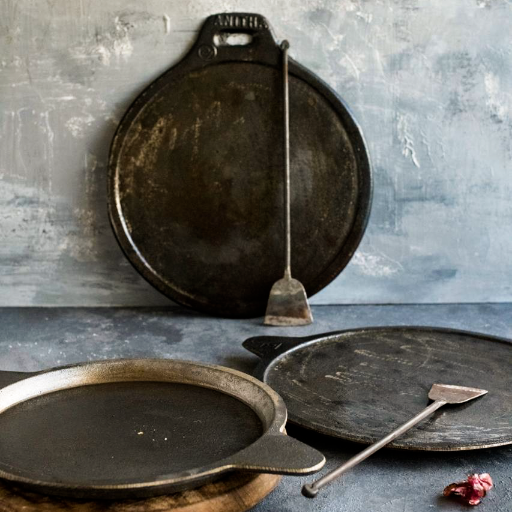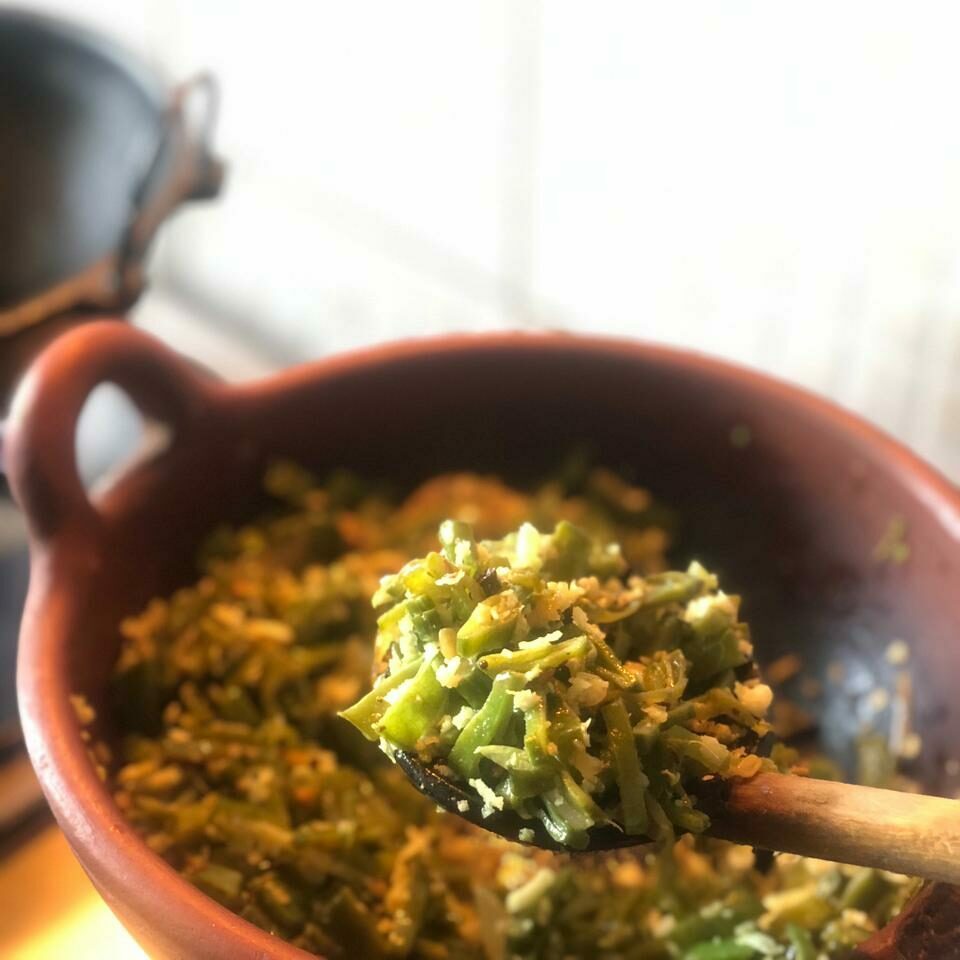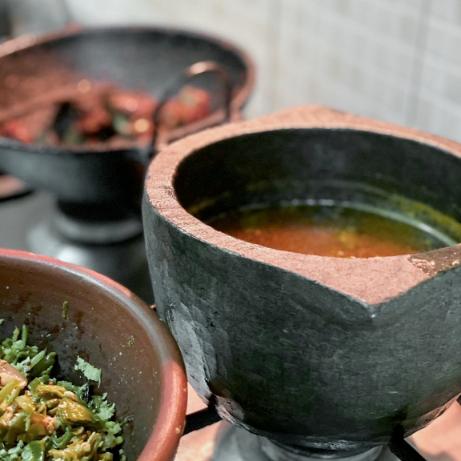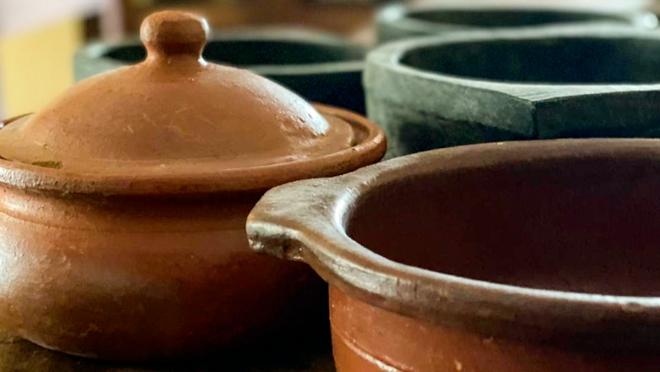An ethical entrepreneur tells us about the benefits and ease of using traditional cookware.
Our team loves cooking as much as we do exploring the city’s souks and restaurants. While you’ll often find us admiring the produce at our local markets or spending hours pouring over cookbooks, many of us on the team are also cookware addicts. It takes us all the willpower in the world to resist investing in just that one additional pot or pan that we don’t already own!
This is why we were so excited to connect with a traditional cookware expert, Faiza, from Earth and Ethics (@earthandethics) on this episode of the Deep Fried Podcast. She tells us all that we need to know about traditional cookware—the benefits of using them, how to use, clean and maintain them—and even how they can make you a better cook by adding flavour to your food and possibly preventing a few cooking mishaps.
Though, rather than talk about specific pots and pans, we explore the different materials traditional cookware are made with, and how that influences what we can cook with them. Tune in to our podcast using the player below to hear Faiza talk about Cast Iron, Clay and Soap Stone cookware. We’ve also put these in a convenient list below with the benefits, and usage and maintenance instructions for each.
Faiza is an MBA grad and mother of 2 who started Earth and Ethics with a mission to bring back all of her things used in her grandmothers’ kitchens and stored in their cupboards. She stocks not just handmade, pre-seasoned cookware but also spoons and utensils that can be used with them alongside artisanal, block-printed home linens.
Want more of our scrumptious podcast episodes? Feast on our main podcast page here!
Subscribe on: Apple Podcast App | Spotify (available on AppStore and Google Play) | Stitcher (available on AppStore) | Google Podcasts | Anghami
1. Cast Iron Traditional Cookware

Cast Iron Pans from Earth and Ethics
The most well-known material for traditional cookware these days, across cultures, is cast iron – an alloy made with iron, carbon, silica and manganese that is formed into objects by pouring the molten alloy into sand casts that are left to cool before heat treatment and surface finishing. Cast iron cookware is usually heavy not just due to the density of the material but also thanks to the thickness required for casting.
Benefits of Cast Iron:
- Rather than wearing out like more modern coated cookware, cast iron traditional cookware gets better with use and age as the oil used to cook and maintain the pan polymerizes with heat to form a natural, glassy, non-stick coating.
- This patina formed with age is not toxic, unlike the synthetic non-stick coating on aluminium pans.
- The coating also absorbs complex flavours over time and imparts them to food cooked in these wares improving the taste. The pan/pot is a secret ingredient!
- This might contribute to the flavour of nostalgia—users often mention how it makes food taste like it used to, connecting diners with the past and stories
- Even novice cooks can use it. Faiza herself claims to be an average cook but credits her own traditional cookware as an ally in making her food taste better.
- Cast iron cookware can easily be transferred to the oven for long and slow cooking without any worries about damaging plastic parts on modern pans, like handles, and toxic fumes.
- The caramelization and searing you get are unparalleled because cast iron has great emissivity in addition to its heat retention properties.
How to use Cast Iron traditional cookware?
- Cast iron traditional cookware needs to be seasoned before you use it.
- Faiza pre-seasons the cookware she sells by hand with coconut oil before delivery. (She also used sesame oil before, but now avoids it to make it safe for those with nut allergies)
- Rinse the cookware lightly and dry it before first use, heating it to evaporate any remaining moisture.
- It’s best to avoid acidic ingredients like tomatoes and tamarind in cast iron wares and she recommends cooking with these in clay or soap-stone ones.
How to clean and maintain Cast Iron traditional cookware?
- You don’t need to wash the cookware if you have only cooked dry items (like pancakes or dosai in it), just remove any remaining bits of food and wipe clean.
- If you do feel the need, wash only when the cookware has cooled to room temperature to prevent thermal shock which can damage the coating and even the pan.
- Use very dilute dish soap to wash as dish soap may affect the coating that you have built up over time.
- After washing, heat the pan on the stove to evaporate any remaining moisture and then apply oil to prevent rusting with a cotton swab or an onion half. Leave to cool before storing.
- Optionally, you can scrub the cookware with coarse salt and a few drops of water to remove more stubborn bits.
- Store in a dry place away from moisture.
What to cook in Cast Iron traditional cookware?
Faiza sells the following cookware and we’ve listed a few examples of what to cook in these:
- Flat dosa pan
- Pancakes
- Dosa (savoury rice and lentil crepes),
- Chilla (savoury gram flour crepes similar to dosa)
- Rotis (Indian home-style flat bread )
- Even eggs (this may be tricky for novices, but it is possible with a well-seasoned pan.)
- Kadai/Wok
- To fry food in any way – deep frying, shallow frying or stir-frying.
- Smaller woks or kadai can be used to make appams or hoppers.
- And even for roasting vegetables like potatoes or broccoli
- Skillet
- To roast meats and vegetables – start these with a sear on the stove top and finish them in the oven.
- Pan-frying – burgers, eggs, fish and boneless chicken breast get deliciously crisp on the outside when cooked in cast iron.
- To bake – pies, pizzas, cobblers, buns, all turn out great in a skillet.
2. Clay Traditional Cookware

Beans Poriyal Cooked in a Clay Pot
Clay is composed of fine silt deposited by rivers on their banks over eons. Even before the potter’s wheel was invented, coiling long columns of moulded clay made it possible to shape cans and pots that were then fired to dry and harden them for use.
Benefits of using Clay:
- Just like cast iron the porous surface of unglazed clay cookware absorbs complex flavours over time and improving the taste of food cooked in it.
- Cooking in clay is believed to be healthy in some circles, particularly for acidic ingredients like tamarind, since the clay is believed to neutralize acidity impart an earthy flavour.
- Faiza says that when cooking vegetables, her clay pot is her trusty ally since the thick, heavy base the pots usually have prevents burning by regulating the heat. Additionally, this also means the vegetables cook faster without you having to resort to a pressure cooker.
- Clay pots can also be used for oven cooking too.
How to use, clean and maintain Clay traditional cookware?
- Just rinse and dry, you don’t even need to oil the pot after use.
- Pots used for cooking fish curries may have a fishy smell after use which can be removed by scrubbing with salt and lemon.
- However, clay pots are brittle and an impact or drop can easily cause one to crack rendering the pot useless for cooking even if it does not break, so they need to be handled with care.
What to cook in Clay traditional cookware?
Faiza says that you can cook everything from soups, stews, curries to porridge and biryanis in the clay pot. the main difference is in the shape:
- Use a deep pot with a lid for soups, curries and rice.
- Broad and shallow kadai-style pots are better for cooking vegetables.
3. Soapstone Traditional Cookware

Soup in a Soapstone pot
Soapstone is a naturally occurring soft rock found*d around the limestone deposits in Tamil Nadu in India and elsewhere in the world. Due to its relative softness, yet durability, Soapstone has been used as a carving medium since ancient times for statues and cookware alike. Pots are hand-carved by artisans from a single stone requiring great skill and effort to make. Although a natural material, soapstone is technically not a renewable resource since it cannot be remade and has to be quarried or mined.
Benefits of using Soapstone:
- Soapstone is believed to be enriched with naturally occurring minerals that are said to fortify the food cooked in it.
- It has good durability and a higher heat retention capacity than cast iron.
- Soapstone tends to thicken curries naturally since the material is relatively porous and seems to absorb water. In a way, it seems to be a living material that interacts with the food.
- Similar to cast iron and clay, age adds a patina and transforms the pot, sometimes even changing the surface colour, making it better with use and adding to the flavour of dishes.
How to use, clean and maintain Soapstone cookware?
- As with clay, rinsing with water and drying is the only cleaning you need. It does not usually harbour any smell of seafood after cooking as clay might.
- Soapstone cookware, like clay pots also need to be handled carefully to avoid drops and shocks.
- The material does have an involved seasoning process, but Faiza makes this super-convenient for customers by pre-seasoning the pots for a week before delivery.
What to cook in Soapstone cookware?
- Its the best vessel to use for thin curries and soups, especially those with acidic ingredients
- Larger soapstone pots can be used as casseroles due to the excellent heat retention.
4. Utensils to use with Traditional Cookware
Faiza also stocks spoons and ladles made from natural materials to use with the above materials, since it defeats the purpose if you’re going to use plastic ones anyway
View this post on Instagram
- Flat iron spatulas for turning and flipping
- Coconut shell ladles with wooden handles
- Faiza also says that steel and wooden utensils are fine to use with all the above materials and will not damage them in any way.

Arva Ahmed is the co-founder of Frying Pan Adventures, Dubai’s first food tour company, and a celebrated food explorer known for uncovering Dubai’s hidden culinary gems. Her expertise in the city’s diverse food scene has been featured in prominent publications such as CNN, Khaleej Times, BBC Travel, The Sun, The Independent and countless more. She also hosts Ditch the Silver on YouTube. Through her immersive tours and storytelling, Arva brings Dubai’s rich flavors and vibrant cultures to life.


